 Welcome to our Picture Gallery.
Welcome to our Picture Gallery. Welcome to our Picture Gallery.
Welcome to our Picture Gallery.
 The Collection
The Collection

Besson, London & France;
4 valve Tenor Horn E flat 1925 s/p
Enharmonic 3 valve Baritone, 1915 s/p
Enharmonic 3 valve Euphonium, 1908 s/p
Enharmonic 4 valve Euphonium, 1919 s/p
Enharmonic 4 valve Euphonium, 1921 s/p
Zephyr 5 valve Euphonium, 1905, brass, valves replated
New Standard 4 valve compensating Euphonium, 1956 s/p
Boosey & Co. London;
Solbron 3 valve Euphonium, circa 1911 brass
Boosey & Hawkes, London;
Imperial 4 valve compensating Euphonium, 1947 brass
Imperial 4 valve compensating Euphonium, 1980 frosted s/p
Conn, USA;
3 valve Euphonium (small, baritone), 1933, lacquer (originally s/p, donated by Doug Ruby from the USA)
Courtois, France;
4 valve Euphonium, circa 1900, brass
F.E. Olds (USA)
2 valve (rotary & piston) marching Baritone in G, 1970’s nickel plated
Ditto horn in E flat
Hawkes & Son, London;
Dictor semi-compensating 4 valve Euphonium, silver plate
5 valve Euphonium, circa 1888, s/p no number
Highams, Manchester UK;
5 valve Euphonium, 1891, brass
5 valve Euphonium, 1902, Rex Model s/p
4 valve ‘Contesting’ Euphonium, circa 1910 s/p
Gisborne, Birmingham, UK;
4 valve non comp Euphonium s/p
Martin; (USA)
E flat Sousaphone, 1958, gold plate
Salvation Army, London;
Super Triumphonic 4v comp Euphonium, March 1965 s/p
Bandmaster 4 valve Euphonium, May 1947 s/p
Bandmaster 4 valve Euphonium, November 1932 frosted s/p
Triumph 4 valve compact Euphonium, 1915 s/p
Willson, Switzerland;
4 valve compensating Euphonium 2950, 1990, s/p
4 valve compensating Euphonium 2900, December 2004, lacquer
Donor/repair/spares instruments;
Besson Enharmonic 4v Euphonium, body & 2 valves only
Ditto 1893 missing 3rd. valve/2nd. slide
Butler of Haymarket 4 valve Euphonium, circa 1900, s/p


A 4 valve compensating Willson 2900 Euphonium, manufactured in December, 2004.
Nestled in a valley surrounded by the Alps in the village of Flums, Switzerland, just a couple of hours drive from Zurich, is the home of the family owned and
operated Willson Band Instrument Company, builders and manufacturers of the world's finest low brass instruments.
Long recognized by professional musicians in North America, Europe, the Orient and Australia as THE euphonium maker, Willson has more recently put its expertise
to work in creating a family of world class professional tubas in Eb, CC, F and BBb; a line of large and medium bore trombones; and a unique ensemble of French horns.
Willy Kurath Sr., a clarinetist and tubist who had earned the coveted Swiss National Brasswind Instrument Maker Certificate started a band instrument repair facility in
1950 and added the fields of brass instrument research, design, development and manufacture. By 1955, Mr. Kurath had decided to devote his energies and considerable talents
to the creation of the world's finest low brass instruments. Old world hand craftsmanship and precision Swiss technology are combined here to ensure the consistency and
quality control in this specialized, limited production of every Willson instrument.
Every step in the manufacturing process is personally supervised by Willy Kurath, Sr. and his son Willi, Jr. - a euphoniumist, business man and also the proud holder
of the National Brasswind Instrument Maker Certificate.
Unique among brasswind instrument producers, Willson ensures the quality and uniformity of its products by manufacturing all of its own parts.
The Willson Company aims to create the highest quality brass instruments by: maintaining intimate contact with musicians to assist with research and development;
combining the most highly skilled hand craftsmanship with modern manufacturing technology; limiting production with a small, but highly skilled and dedicated work force;
and to adhere to strict and respectable business principles, while maintaining a close, friendly relationship with its customers.
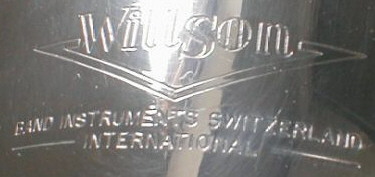



A Salvation Army 4 valve non compensating Euphonium, in silver plate, circa 1933.
This instrument was hand made at the St. Albans factory and sold through Judd Street.
It required a 4th. valve stem that had broken and minor work to the valves.
The first pic above is prior to cleaning, the one below is as it is now. It is a very heavy instrument,
made of thick gauge brass and with a thick coating of silver plate.
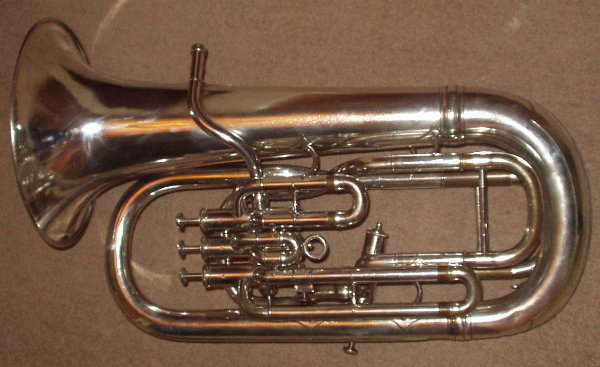
It gives a wonderful dark sound with just minor intonation problems.

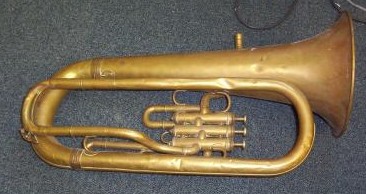
Ths is a Boosey & Co. 3 valve Solbron Light-Valve Euphonium, in brass, circa 1920.
This instrument is in very good condition with just minor dents.
The copper plate on the valves also gives good compression and the sound is excellent.


An F.E. Olds marching Baritone, with one piston, one rotary valve and pitched in G.

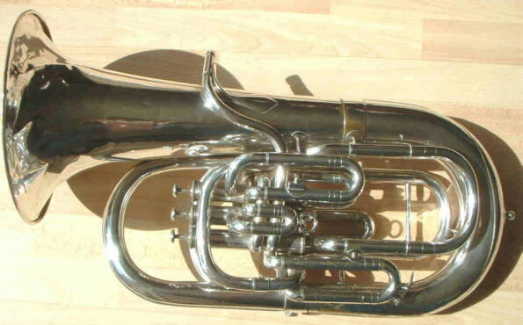
A rare Besson Enharmonic euphonium,
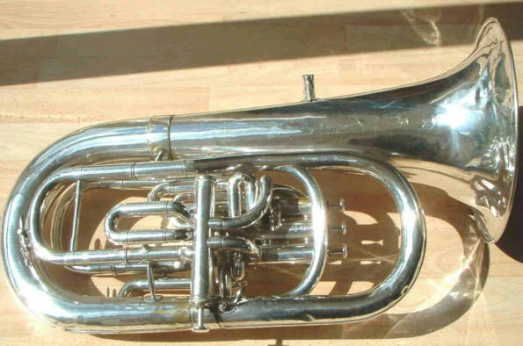
The reverse view showing the 4th. valve position.
Basically, on the enharmonic euphonium, the mouthpipe leads into the 3rd.valve. If the 3rd. valve is not used, the windway leads through into the 1st. & 2nd. valves in
the normal way, and back through the 3rd. to the bell.
If the 3rd. is operated, the windway is lead through the 1st. & 2nd. valves by a different route. including a tuning slide, and in also going through different passages in the
1st. & 2nd. valves, will be directed through seperate longer loops of tubing
(if the 1st.& 2nd. are operated with the 3rd.)
The idea was that it is superior to the compensating system in that the windway is not required to pass through each valve
more than once.
Air is redirected back through on compensating loops.
As with the compensating system, the whole range of valved instruments except Soprano Cornet was available,
the obvious weight problems when you get to tubas in this range must have been enormous, which is probably why only 3 valve models were made.

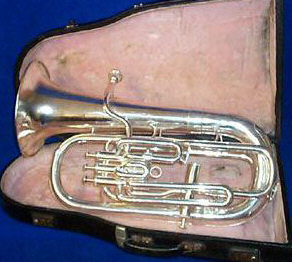
The latest addition, a Highams 'Contesting' euphonium,
this time a 4 valve non-compensating 'Class A' model, made circa 1914. Recently overhauled and replated.
Note the very low position of the 4th. valve.


An old Campbell & Sons 3 valve euphonium, made in their factory at Trongate, Glasgow, around 1900.
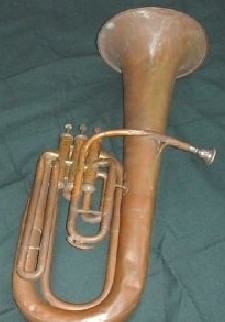
This instrument did blow ok but does have bad 3rd. valve tubing damage and has now donated
its tuning slides for the Highams 5 valve instrument below.


Sue's previous Boosey & Hawkes 955 Sovereign 3 valve compensating 'light bell' baritone.

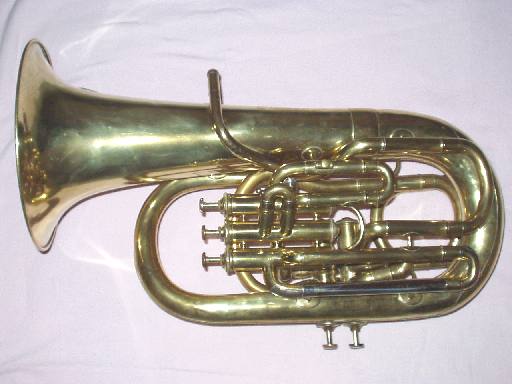
A Highams of Manchester 5 valve, non compensating euphonium.

This is a "Clearbore" model, estimated to be made around 1891.
It has been amazingly restored to playing condition
by Colin Jeffrey of Sheffield.
It is a 5 valve non compensating model that is beautifully made and has a very
sweet sound. Valves 4 & 5 are uncomfortable to use as
they are positioned straight, meaning they are pressed upwards when used. It is also difficult to take the weight in your left hand when the first two fingers are required to work
valves.
It has its original small bore mouthpiece receiver and has had minor solder work to various joints. Valve number 5 gives a great sound as the bore is at its largest on
leaving the valve section.

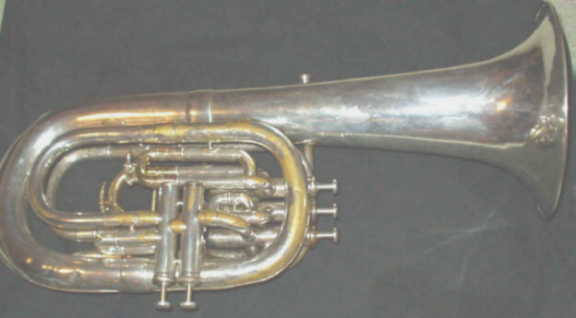
A Highams of Manchester 5 valve, non compensating euphonium.

Another "Clearbore" model, dated 1902. This was missing two slides,
and a 4th. valve stem & cap. All the repairs are now complete.
This design is so different from the earlier model. The instrument is very long (tall) and would prove a problem sitting too close to the next player. It favours the early
Sax design where all the tubing is below the valve line, making it a plumbers nightmare!
It has its original small bore mouthpiece receiver.

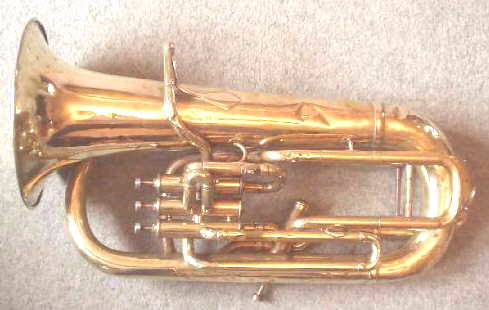
A 4 valve Courtois Euphonium circa 1900.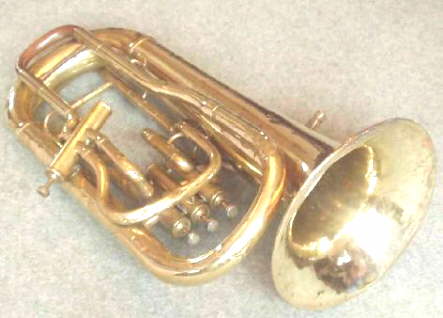
This instrument is a 4 valve non compensating model dating from around 1900.
The seriel number under the 3rd. valve cap dates it at 1860, so maybe they are from another instrument ?
The last date on the bell engraving reads 1889.
The instrument (brass) was rescued from a school collection and is very badly dented, but it plays beautifully!
The conversion to low pitch is not too bad, though too much tubing on the 4th.valve slide makes it flat.
We have fitted a large size mouthpiece receiver.

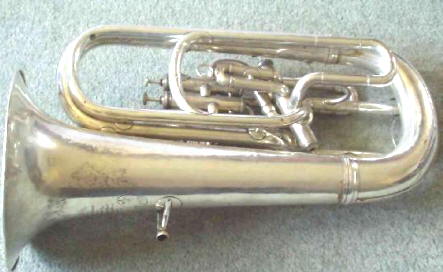
A 4 valve Hawkes Dictor euphonium circa 1918.

The bell engraving.
This is our latest addition to the collection and is a rare Hawkes model dating around 1918, where the instrument is only compensated
on the 4th. valve, which gives you B (C# treble clef) and not C (D treble clef).
The additional link of tubing from valves 3 & 4 can be seen on the reverse picture.
On the bell are circles that give the fingering (3 & 4) for C# below the stave (bass clef).
It is an unusual design, the 4th. valve casing measures some 8 inches in length.
It has been converted to low pitch but still has the old medium bore mouthpiece receiver.


A 3 valve Besson euphonium circa 1915.
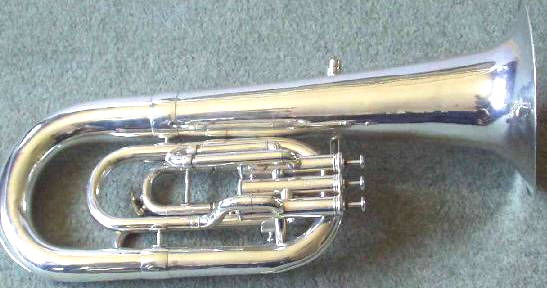
This is a French Besson Euphonium, kindly donated to us by a friend, and dates around 1915. It is a 3 valve non compensating instrument
that was replated a while ago, though damage to the bell is still quite noticeable.
It is strange to hold as the original Sax design has no hand-bar to rest the thumb. The instrument is very light and well balanced, the brass though is of thin construction.
Once again a large receiver was fitted to the previous medium bore mouthpiece shank. The instrument has now been donated to a brass group in the Salvation Army in Italy.

Collecting Old Euphoniums.

Email us here. 
Return to the homepage go to the picture gallery index

